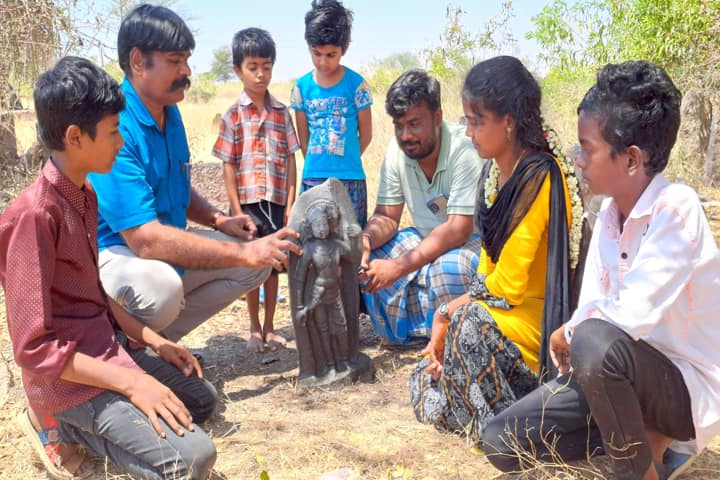

The 600-year-old hero stone depicting the archer
Ancient sculptures provide insight about the era they were built in and the people who lived in that period. That is what a 600-year-old hero-stone archer discovered and studied in Vedanatham village in Tamil Nadu’s Virudhunagar district precisely does.
The information about this hero-stone was provided by P. Silambarasan, a teacher to V. Rajaguru, president of Ramanathapuram Archaeological Research Foundation who along with students, V.Sivaranjani, A. Mohammad Sahabdeen and S. Srivipin explored the area.
Sharing details about the archer sculpture with India Narrative, Rajaguru informed that it is a standalone statue which has been carved in granite stone. “Its height is 60 cm, width is 26 cm and thickness is 16 cm and the hero stands with a bow in his left hand and an arrow in his right hand, which is lowered. While the bow is longer than him, the quiver which is placed on his right shoulder is full of arrows. A short sword can also be seen tucked in his waist.”
He also informed India Narrative that the dress that the hero adorns is knee-length and that he has a garland around his neck. “This sculpture which is beautifully and elegantly carved shows the hero wearing bracelets on his hands, warrior anklet on his feet, and earring in the ears while his moustache is turned upwards. Based on the style of the sculpture, S. Santhalingam, an archaeologist, has confirmed that it belongs to the 14th-15th Century AD Vijayanagara period.”
The style in which the bow and arrow has been carved is similar to that which is visible in the sculptures of Lord Rama and Lakshmana belonging to the Vijayanagara period as evident in the Thirupullani Perumal Temple.
Apart from this hero-stone, the team also found a 3-feet high sati stone depicting a husband and a wife. Describing it, Rajaguru said: “While the man placed on the left side is shown carrying a sword in his right hand, his left hand is resting on the thigh. The woman is shown on the right side raising her right hand and holding a bouquet in her left hand which is resting on the thigh. It probably belongs to the 15th Century AD.”
Two more hero-stones were also found and they as per Rajaguru belong to the 17th or 18th Centuries AD.
The custom of making hero-stone sculptures and installing them began in the 14th Century and continues till today in this village. “This practice is followed to celebrate warriors who lost their lives in protecting the town from enemies or fighting wild animals like a tiger, boar, and elephant to save people. It helps to know the history and customs of the common people,” explained Rajaguru.
The Israeli Defence Forces shared that on Thursday night it targeted the missiles manufacturing sites…
Prime Minister Narendra Modi is set to flag off the Vande Bharat Express connecting Patliputra…
Ranked 4th among the world's five largest economies, India holds a critical position in shaping…
Ahead of the International Day of Yoga, Saima Wazed, Regional Director for WHO South-East Asia…
The Indian Army, in collaboration with Indian diplomatic missions and cultural centres, is commemorating the…
The Elon Musk-headed SpaceX's newest Starship exploded ahead of a routine engine test in Texas,…